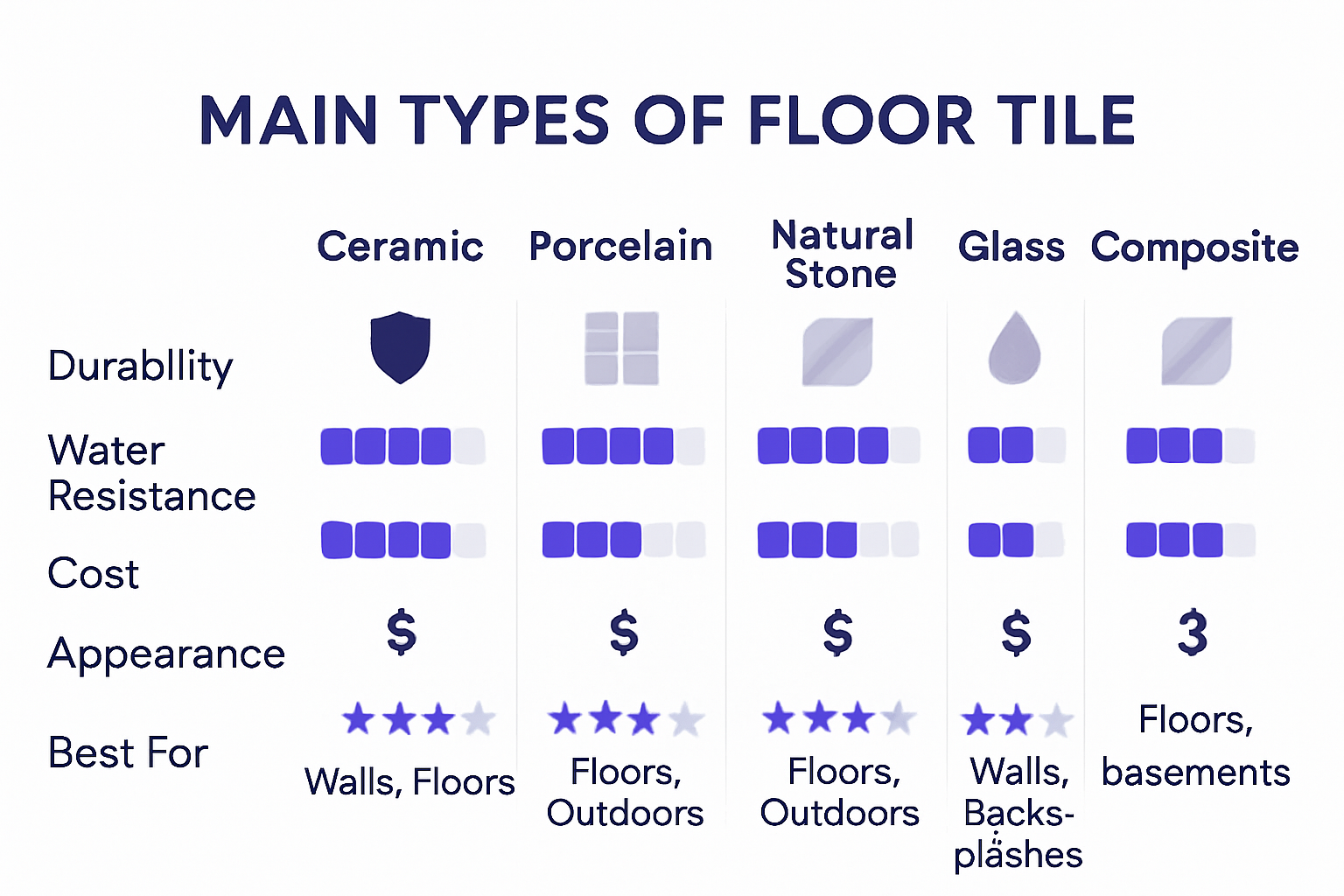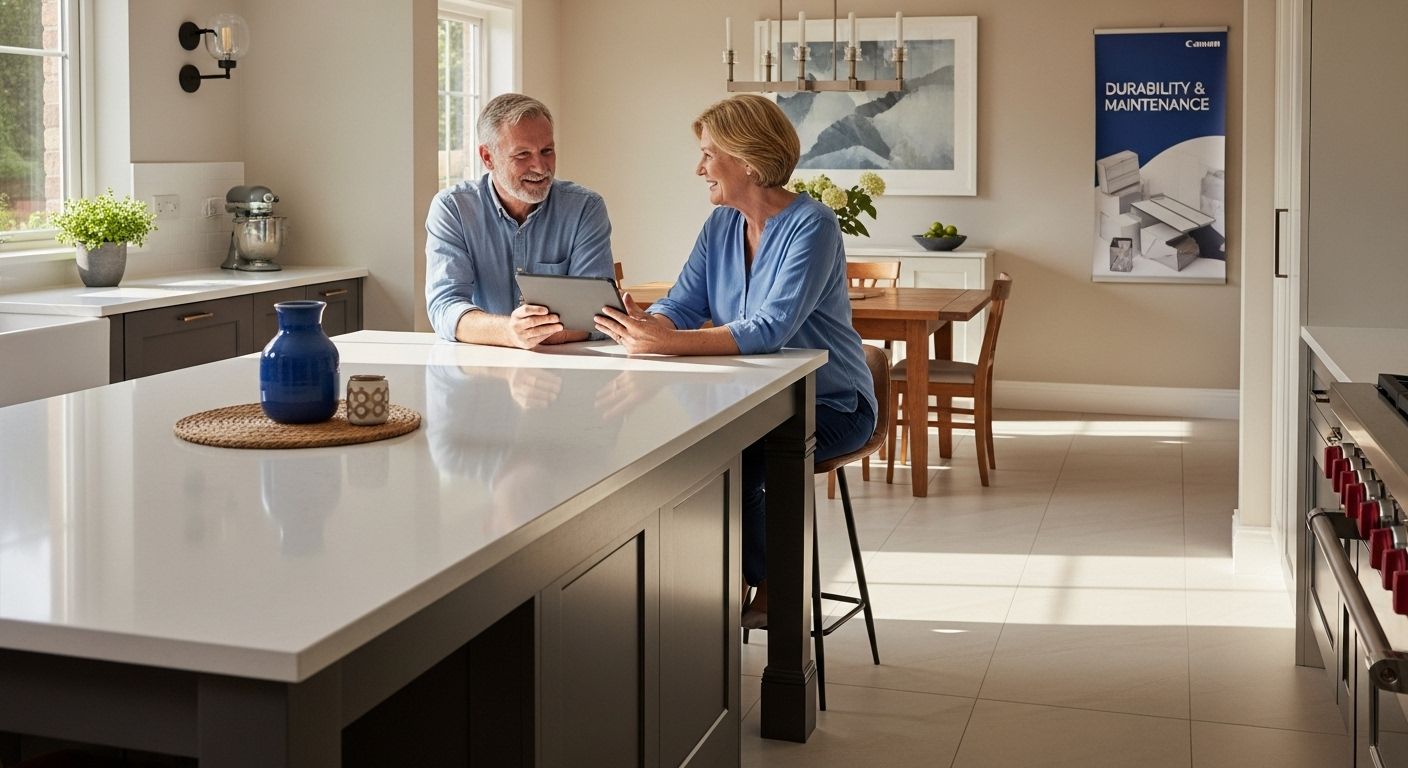What is Floor Tile? Understanding Types and Benefits
Posted by Mike Belk on Aug 24, 2025

Floor tiles do a lot more than just cover the ground. They completely change the mood, look, and function of any space, from apartments to shops. Now think about this. Ceramic and porcelain tiles start as regular clay but become incredibly tough—so dense they stand up to years of heavy foot traffic and moisture without breaking a sweat. Most people focus on how a tile looks, but the real secret lies in the advanced science and durability packed into every piece. That hidden strength and engineering is what truly redefines how we live with tile.
Table of Contents
- Defining Floor Tile: Materials and Types
- Importance of Floor Tile in Home Design
- How Floor Tiles Work: Durability and Maintenance
- Choosing the Right Floor Tile: Key Considerations
- Trends in Floor Tile Designs and Applications
Quick Summary
| Takeaway | Explanation |
|---|---|
| Choose tiles based on environment | Assess moisture, foot traffic, and temperature variations to select appropriate tile types for specific spaces. |
| Prioritize durability and maintenance | Opt for tiles with high resistance to wear, stains, and moisture for long-lasting beauty and functionality. |
| Consider aesthetic versatility | Utilize the wide range of colors, patterns, and textures tiles offer to enhance your interior design and personal style. |
| Understand performance characteristics | Evaluate tiles’ attributes like breaking strength and chemical resistance to ensure they meet project needs for safety and longevity. |
| Stay updated on design trends | Embrace innovations in tile design, such as digital printing and large formats, for modern, sophisticated floor solutions. |
Defining Floor Tile: Materials and Types
Floor tile represents a versatile and durable flooring solution designed to cover horizontal surfaces in residential and commercial spaces. These engineered materials transform spaces through their combination of aesthetic appeal and functional performance, offering homeowners and designers multiple options for creating visually stunning and practical floor surfaces.
Understanding Tile Composition
At its core, floor tile is manufactured from various raw materials processed into uniform shapes and sizes. The primary material categories include ceramic, porcelain, natural stone, glass, and composite materials. Each material offers unique characteristics that determine its suitability for different environments and applications.
- Ceramic Tiles: Made from clay mixtures fired at high temperatures
- Porcelain Tiles: Dense, less porous ceramic variant with enhanced durability
- Natural Stone Tiles: Extracted and cut from quarried stone like marble, granite, and slate
The manufacturing process involves carefully selecting raw materials, shaping them through pressing or molding, and then firing them in industrial kilns. This process transforms basic materials into robust floor coverings capable of withstanding significant foot traffic and environmental challenges.
To help you easily compare the main types of floor tiles mentioned in this article, the following table summarizes their key characteristics and best-use scenarios.
| Tile Type | Material Description | Key Features | Best Applications |
|---|---|---|---|
| Ceramic | Clay mixtures fired at high temperatures | Affordable, diverse designs, reasonably durable | Residential floors, low-traffic |
| Porcelain | Dense, less porous ceramic variant | Highly durable, moisture resistant, low maintenance | High-traffic, wet areas, commercial |
| Natural Stone | Quarried and cut from stone (e.g., marble, granite, slate) | Unique look, durable, can be porous, requires sealing | Luxury spaces, entryways |
| Glass | Manufactured glass panels | Modern look, stain proof, susceptible to scratching/chip | Decorative, low-traffic areas |
| Composite | Blend of natural & synthetic materials | Versatile, blend of properties from other types | Varied, depends on composition |
Tile Classification and Applications
Floor tiles are classified not just by material but also by their intended use and performance characteristics. Explore our comprehensive tile selection guide to understand how different tile types match specific spatial requirements.
Commercial and residential environments demand different tile properties. For instance, high-traffic commercial spaces require tiles with superior wear resistance, while residential areas might prioritize aesthetic appeal and comfort. The classification considers factors like:
- Water absorption rate
- Coefficient of friction
- Breaking strength
- Chemical resistance
- Thermal shock resistance
Understanding these technical specifications helps professionals and homeowners select the most appropriate floor tile for their specific project needs, ensuring longevity, safety, and visual appeal. Each tile type brings its own set of advantages, transforming spaces through carefully selected materials and design solutions.

Importance of Floor Tile in Home Design
Floor tiles transcend mere functional surfaces, emerging as critical design elements that dramatically transform interior and exterior spaces. These versatile materials serve as foundational aesthetic and practical components in modern architectural and interior design strategies, offering homeowners unprecedented opportunities to express personal style while maintaining structural integrity.
Aesthetic and Visual Impact
Tiles provide an extraordinary canvas for visual storytelling within living spaces. Unlike traditional flooring options, they offer an expansive range of colors, patterns, textures, and design possibilities that can dramatically alter a room’s perception and emotional atmosphere. Design professionals recognize tiles as powerful visual communication tools that can make spaces feel larger, more intimate, cohesive, or dramatically contrasting.
Key visual design capabilities include:
- Creating visual depth and dimension
- Establishing color harmony and contrast
- Defining spatial boundaries and architectural zones
- Reflecting personal aesthetic preferences
Functional Performance in Design
Beyond aesthetic considerations, floor tiles deliver remarkable functional performance that integrates seamlessly with design objectives. Learn about selecting perfect tiles for different spaces to understand their multifaceted design potential.
The performance characteristics of floor tiles directly impact design sustainability and long-term visual appeal. Tiles engineered with advanced material technologies provide:
- Exceptional durability against wear and environmental stress
- Resistance to moisture, stains, and bacterial growth
- Low maintenance requirements
- Thermal and acoustic insulation properties
By combining aesthetic versatility with superior functional attributes, floor tiles represent a sophisticated design solution that bridges beauty and practicality. Architects and interior designers leverage these materials to create spaces that are not just visually compelling but also engineered for enduring performance and user comfort.
How Floor Tiles Work: Durability and Maintenance
Understanding the intricate mechanisms behind floor tile durability and maintenance reveals the sophisticated engineering that makes these materials exceptional long-term flooring solutions. Floor tiles are designed as complex systems that combine material science, manufacturing precision, and advanced protective technologies to withstand significant environmental challenges.
Material Resilience Mechanisms
The durability of floor tiles stems from their fundamental molecular structure and manufacturing processes. During production, tiles undergo intense heat treatments and compression that fundamentally alter their physical properties. Ceramic and porcelain tiles, for instance, transform from soft clay into extraordinarily dense, hard surfaces capable of resisting substantial mechanical stress.
Key resilience characteristics include:
- Molecular density prevention of microscopic fractures
- Compression resistance during manufacturing
- Thermal shock tolerance
- Surface tension reduction
Maintenance and Protective Strategies
Discover professional tile maintenance techniques to maximize your floor’s longevity and aesthetic appeal. Effective tile maintenance goes beyond simple cleaning, involving strategic protective approaches that preserve the material’s inherent qualities.
Advanced maintenance involves multiple interdependent strategies:
- Regular cleaning with pH neutral solutions
- Periodic sealing of porous surfaces
- Prompt addressing of potential damage indicators
- Professional assessment of wear patterns
The scientific approach to tile maintenance recognizes that these surfaces are not static but dynamic materials responding to environmental interactions. Professionally maintained tiles can retain their structural integrity and visual appeal for decades, representing a sophisticated intersection of material engineering and proactive care. By understanding the underlying mechanisms of tile performance, homeowners and design professionals can make informed decisions that extend their flooring’s functional and aesthetic lifespan.

Choosing the Right Floor Tile: Key Considerations
Selecting the perfect floor tile requires a comprehensive evaluation of multiple interconnected factors that extend far beyond simple aesthetic preferences. Homeowners and design professionals must navigate a complex landscape of performance characteristics, spatial requirements, and long-term functional expectations when making tile selection decisions.
Performance Environment Assessment
Understanding the specific environmental conditions is crucial in tile selection. Different spaces demand unique tile characteristics based on exposure to moisture, temperature fluctuations, foot traffic intensity, and potential chemical interactions. A tile that performs exceptionally in a bathroom might fail dramatically in a commercial kitchen or outdoor patio.
Critical environmental factors include:
- Moisture exposure levels
- Temperature range variations
- Anticipated foot traffic intensity
- Potential chemical or mechanical stress
- Sunlight and UV exposure
Material Compatibility and Design Integration
Explore alternative tile options for your specific space to understand the nuanced relationship between material selection and design objectives. The ideal tile must harmonize functional requirements with aesthetic aspirations, creating a cohesive visual and performative solution.
Key design and compatibility considerations include:
- Color and texture alignment with existing design elements
- Dimensional proportions relative to room size
- Complementary design language
- Potential for future design modifications
- Budget constraints and long-term value
The art of tile selection transcends simple material choice, representing a sophisticated intersection of engineering, design philosophy, and practical performance requirements. Successful tile selection demands a holistic approach that considers immediate visual impact and long-term functional sustainability. By methodically evaluating environmental conditions, design objectives, and material characteristics, professionals can transform floor surfaces into dynamic, enduring architectural elements.
The table below outlines the main factors to consider when selecting a floor tile, helping you match environmental and design needs with the right tile characteristics.
| Consideration | Description |
|---|---|
| Moisture Exposure | Level of water or humidity the tile will encounter |
| Temperature Fluctuations | Range and changes in temperature within the space |
| Foot Traffic Intensity | How much wear from people moving across the floor |
| Chemical/Mechanical Stress | Potential for exposure to chemicals or physical impacts |
| Sunlight/UV Exposure | Amount of direct sunlight or UV that may affect the tile |
| Design Compatibility | Alignment with colors, textures, and style of the room |
| Room Proportions | Tile size and layout in relation to room dimensions |
| Budget & Long-term Value | Cost considerations and expected longevity |
Trends in Floor Tile Designs and Applications
Modern floor tile design represents a dynamic intersection of technological innovation, aesthetic exploration, and functional performance. Contemporary trends reflect an evolving understanding of how floor surfaces can transcend traditional boundaries, transforming from purely utilitarian elements to sophisticated design statements that communicate architectural narrative and personal style.
Innovative Material and Visual Expressions
Technological advancements have revolutionized tile manufacturing, enabling unprecedented design flexibility and material mimicry. Designers and manufacturers now produce tiles that convincingly replicate natural materials like wood, marble, and concrete while maintaining superior durability and performance characteristics.
Emerging design innovations include:
- Hyper realistic texture reproduction
- Large format tile configurations
- Seamless material transitions
- Multidirectional visual patterns
- Integrated digital printing technologies
Functional Design and Spatial Transformation
Discover cutting edge tile design possibilities to understand how modern tiles reshape spatial perceptions. Contemporary tile applications go beyond traditional floor coverage, becoming integral components of holistic design strategies that blur boundaries between surfaces and architectural elements.
Key functional design trends encompass:
- Modular tile configuration systems
- Adaptive color-changing technologies
- Integrated thermal and acoustic properties
- Sustainable material compositions
- Customizable surface interactions
The evolution of floor tile design represents more than aesthetic progression. It signals a profound reimagining of how architectural surfaces can dynamically interact with human environments, balancing technological capability, design innovation, and functional performance. As materials science continues advancing, floor tiles are transforming from passive design elements into active, responsive architectural components that engage and enhance spatial experiences.
Transform Your Space With the Right Tile Choice
Choosing the perfect floor tile can feel overwhelming, especially when trying to balance durability, style, and long-term maintenance. As outlined in our article, understanding the differences in materials like ceramic, porcelain, and natural stone is key if you want results that look incredible and last. Many homeowners and professionals struggle with this decision because every room and project brings its own set of challenges, from high-traffic commercial spaces to moisture-prone residential areas.
Make your next flooring upgrade easier by exploring the curated collections at BELK Tile. Our platform provides detailed product specs and inspiring images so you can find the perfect match for your needs and style vision. Ready to put your knowledge into action and enjoy a floor that truly stands out? Visit BELK Tile today and browse hundreds of options designed to help you achieve lasting beauty and performance.
Frequently Asked Questions
What are the different types of floor tiles?
Floor tiles come in several types, including ceramic, porcelain, natural stone, glass, and composite materials. Each type has unique characteristics suited for various applications and environments.
How do I choose the right floor tile for my space?
Choosing the right floor tile involves assessing the specific environmental conditions, such as moisture exposure and foot traffic intensity. Additionally, consider the design compatibility and material characteristics to ensure a cohesive look and long-term durability.
What are the benefits of using porcelain tiles?
Porcelain tiles are known for their durability and low porosity, making them resistant to moisture, stains, and wear. They are ideal for high-traffic areas and are available in a wide range of designs that mimic natural materials.
How do I maintain floor tiles to ensure longevity?
To maintain floor tiles, regularly clean them with pH-neutral solutions, periodically seal porous surfaces, and promptly address any signs of damage. Professional assessments can help evaluate wear patterns and enhance longevity.



